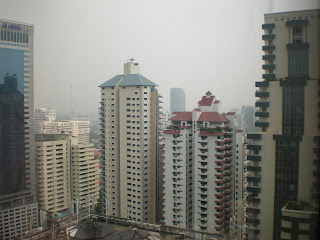
El alfabeto thai deriva del alfabeto khmer (อักขระเขมร), que está inspirado en la letra brahmí de las lenguas indo-arias. Al igual que los birmanos adoptaron el alfabeto Mon (que también tiene orígenes índicos), los thais adoptaron una forma modificada de alfabeto khmer para crear su propio sistema de escritura. Mientras que la más antigua inscripción conocida en la lengua khmer data del 611 d.C., las inscripciones en alfabeto thai empezaron a aparecer alrededor de 1292 d.C. Sus características más notables incluyen: por un lado posee una escritura abugida, en la que la vocal implícita es una /a/ corta para las consonantes que se presentan solas y una /o/ corta si la consonante inicial o el grupo va seguido de otra consonante, por otro los marcadores de tono se colocan en la parte superior de la consonante inicial de una sílaba o en la última consonante de un grupo consonante inicial, y por último, las vocales asociadas con consonantes no son secuenciales: se puede colocar libremente antes, después, arriba o abajo de su consonante asociada, o en una combinación de estas posiciones. Esto último causa problemas para la codificación informática y representación de textos.
No hay ningún estándar universal para transcribir el tailandés, lo cual hace que su estudio o comprensión sea aún mayor difícil. Por ejemplo, el nombre del rey Rama IX, actual monarca del país, se transcribe de varias formas, como Bhumibol o Phumiphon entre otras. Las guías, libros de texto y diccionarios pueden seguir diferentes sistemas de transliteración, razón por la cual la mayoría de los cursos de lengua thai recomienda a los estudiantes aprender y dominar el alfabeto tailandés, el cual se compone de cuarenta y cuatro letras (casi el doble que nuestro querido abecedario romano) tipográficamente atractivas pero completamente indescifrables e impronunciables para cualquier boca `farang´.
Lo más parecido a un estándar es el Sistema General de Transcripción de Thai Real, publicado por el Real Instituto de Lengua Thai solamente en esta lengua. Este sistema es cada vez más utilizado por el gobierno central de Tailandia y sus delegaciones regionales, especialmente en los indicadores de tráfico. La principal crítica a este sistema es que no indica ni el tono ni la longitud vocal, por lo que no es posible reconstruir la pronunciación thai a partir de las dichas transcripciones.
Existe publicado un estándar internacional de transliteración de Thai al alfabeto romano en septiembre de 2003. Añadiendo signos diacríticos a las letras latinas hace la transcripción reversible, convirtiéndola en una verdadera transliteración. Este sistema está dirigido al uso académico y apenas es utilizado en Tailandia para la gente de a pié.
Gracias a esta tremenda incompresión tipográfica, a pesar de dedicar parte del tiempo libre a estudiar la lengua local, en este sentido, el día a día en este país se vuelve de lo más desafiante. Sobre todo cuando uno se introduce en un restaurante tradicional thai y observa el menú del día. Ante semejante realidad, lo único que se puede hacer es sonreír y apuntar con los dedos cruzados.
(Thai language)
The Thai alphabet is derived from the Khmer alphabet (อักขระเขมร), which is modeled after the Brahmic script from the Indic family. The language and its alphabet are closely related to the Lao language and alphabet. Most Laotians are able to read and understand Thai, as more than half of the Thai vocabulary, grammar, intonation, vowels and so forth are common with the Lao language. Much like the Burmese adopted the Mon script (which also has Indic origins), the Thais adopted and modified Khmer script to create their own writing system. While the oldest known inscription in the Khmer language dates from 611 CE, inscriptions in Thai writing began to appear around 1292 CE. Notable features include: by one side, it is an abugida script, in which the implicit vowel is a short /a/ for consonants standing alone and a short /o/ if the initial consonant or cluster is followed by another consonant, by other side, tone markers are placed above the initial consonant of a syllable or on the last consonant of an initial consonant cluster and lastly, vowels associated with consonants are nonsequential so they can be located in a free way before, after, above or below their associated consonant, or in a combination of these positions. The latter in particular causes problems for computer encoding and text rendering.
There is no universal standard for transcribing Thai into the Latin alphabet. For example, the name of King Rama IX, the present monarch, is transcribed variously as Bhumibol, Phumiphon, phuuM miH phohnM, or many other versions. Guide books, text books and dictionaries may each follow different systems. For this reason, most language courses recommend that learners master the Thai alphabet, which has forty-four letters (nearly double number than our roman alphabet), typographically attractive but completely indecipherable and unpronounceable for any `farang´ mouth.
What comes closest to a standard is the Royal Thai General System of Transcription published by the Thai Royal Institute only in Thai. This system is increasingly used in Thailand by central and local governments, especially for road signs. Its main drawbacks are that it does not indicate tone or vowel length. It is not possible to reconstruct the Thai spelling from those transcriptions.
There is published an international standard for the transliteration of Thai into Roman script in September 2003. By adding diacritics to the Latin letters, it makes the transcription reversible, making it a true transliteration. This system is intended for academic use and is hardly ever used in Thailand for the common public.
Thanks to this huge typographical misunderstanding, despite the fact of investing some spare time to study the local language, in this way, this country daily becomes so much challenging. Moreover when you get inside a traditional thai restaurant and you stare at the menu. Facing such image, the only thing you can do is laugh and point with two finger-crossed.

.jpg)









